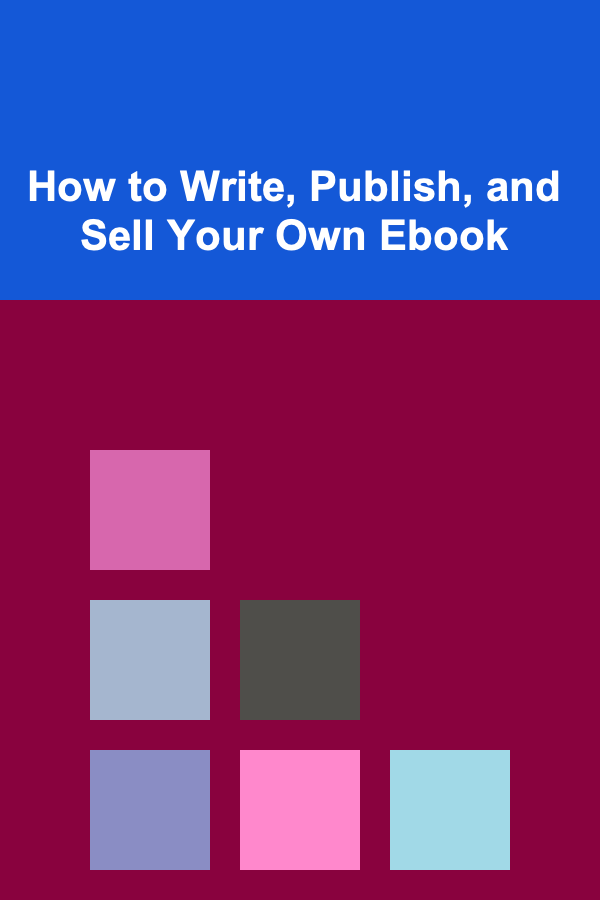
How to Write, Publish, and Sell Your Own Ebook
ebook include PDF & Audio bundle (Micro Guide)
$12.99$11.99
Limited Time Offer! Order within the next:

Writing, publishing, and selling your own ebook has become more accessible than ever before. With advancements in technology and platforms that cater to independent authors, creating an ebook is a highly feasible venture for anyone interested in sharing their knowledge, stories, or expertise with a wider audience. Whether you're a seasoned writer or someone exploring their creative side, this guide will take you step-by-step through the entire process---from writing the ebook to publishing and selling it for profit.
Preparing to Write Your Ebook
Before you start typing away, it's essential to have a clear vision of your ebook's purpose, target audience, and overall structure. This planning stage can determine the success of your project.
Defining Your Purpose and Niche
The first step in writing an ebook is identifying the purpose of your book. What is the main message or value that you want to convey? Are you writing a guide, a novel, a memoir, or a self-help book? Knowing your purpose will help you stay focused and consistent throughout the writing process.
Consider these questions:
- Who is your target audience? Understanding who you are writing for will shape the tone, language, and depth of your content.
- What is your niche? This helps you tailor the content to a specific group of people who are more likely to appreciate and engage with your work.
For example, if you are writing a self-help book on mindfulness, your target audience might be individuals who are seeking stress relief or personal growth. In contrast, a novel would appeal to readers who enjoy fiction within a specific genre, like romance or science fiction.
Outlining Your Ebook
Once you've defined your niche and purpose, it's time to outline your ebook. A good outline will serve as a roadmap, making it easier for you to structure your thoughts and maintain a coherent flow throughout the book. Here are some strategies for creating an outline:
- Introduction: Introduce the problem, topic, or premise you will explore in the book. Engage your reader by offering a hook---something that makes them want to keep reading.
- Main Sections: Break down the content into several sections or chapters. Each section should tackle a specific subtopic or part of the larger theme.
- Conclusion: Summarize the main points and leave the reader with actionable insights or a final thought.
By dividing your content into digestible pieces, it becomes easier to manage the writing process and ensure that the information is well-organized.
Writing Your Ebook
With your outline in place, it's time to begin the writing process. Writing an ebook can seem daunting, but if you break it down into manageable goals, it becomes far less intimidating.
Set a Writing Schedule
Consistency is key when writing an ebook. Set aside dedicated time each day or week to write. It doesn't have to be long sessions---writing a few hundred words each day can add up over time. Whether it's 30 minutes a day or several hours on weekends, a consistent schedule will keep you on track.
- Tip: Set small, achievable goals for each writing session (e.g., 500 words per day) to make progress without feeling overwhelmed.
Write the First Draft
The first draft is all about getting your ideas down on paper. Don't worry about perfection at this stage. Focus on completing the manuscript and expressing your ideas. You can always edit and refine the content later. If you find yourself getting stuck, try to push through the moment and continue writing. The key is to keep the momentum going.
Revise and Edit
After completing the first draft, step back and let your manuscript rest for a while. Returning to it after a break will give you a fresh perspective. Begin editing with a focus on structure, clarity, and coherence. Are your ideas clearly presented? Is the flow logical from one section to the next? During this phase, look for areas where you can improve or elaborate on your ideas.
Don't be afraid to cut sections that don't add value. Editing is a vital part of writing, and it's often where the real quality of your work emerges.
- Tip: Consider using editing tools like Grammarly or ProWritingAid to catch grammar and style mistakes.
Proofreading
Once you've edited your ebook, it's time for proofreading. Look for typographical errors, misspelled words, and inconsistencies. You can also read your ebook aloud to ensure that the sentences flow smoothly and make sense.
Consider enlisting a professional proofreader if you're unsure about your ability to catch every mistake. A fresh set of eyes can identify issues you might have missed.
Formatting Your Ebook
The way your ebook is formatted plays a significant role in how readers experience it. Poor formatting can make your book hard to read, which could discourage potential buyers.
Ebook Formats
Different platforms and devices support different ebook formats, and it's important to format your ebook properly for the widest reach. Some of the most popular ebook formats include:
- EPUB: This is the most commonly used format for ebooks. It's supported by most platforms like Apple Books, Kobo, and Nook.
- MOBI: This format is used by Amazon Kindle, the largest ebook retailer.
- PDF: This format is great for documents that need to retain their original layout, but it can be less flexible for ebook readers.
- HTML: If you're planning to publish your ebook on your website, HTML may be an ideal format.
Ebook Layout
Ensure that your ebook is easy to read on any device. Some formatting tips include:
- Font: Use a clear, legible font like Arial or Times New Roman. Avoid overly decorative fonts.
- Margins and Spacing: Maintain standard margins and adequate line spacing to prevent the text from feeling cramped.
- Table of Contents: Include an interactive table of contents that links to the chapters, making it easier for readers to navigate.
- Images: If you include images, make sure they are high-quality and appropriately sized for different devices.
Using Formatting Tools
There are a variety of tools that can help you format your ebook properly. Some popular ones include:
- Scrivener: A powerful writing tool that allows you to organize and format your ebook.
- Calibre: A free, open-source ebook management tool that can convert and format ebooks in different formats.
- Reedsy Book Editor: A free online tool that helps you format and prepare your ebook for publishing.
Publishing Your Ebook
Once your ebook is written and formatted, it's time to publish. You have two primary options when it comes to publishing your ebook: self-publishing and traditional publishing. In this section, we'll focus on self-publishing, which has become the go-to option for many independent authors.
Choosing a Platform
There are several platforms available for self-publishing ebooks. The most popular ones include:
- Amazon Kindle Direct Publishing (KDP): Amazon is the largest ebook retailer, and KDP allows you to self-publish and distribute your ebook worldwide.
- Smashwords: Smashwords is another major ebook distribution platform that helps you publish and distribute your ebook to various retailers.
- Draft2Digital: This platform offers similar services to Smashwords, allowing you to distribute your ebook to multiple platforms.
- Apple Books: If you're targeting Apple users, publishing through Apple Books can be a good option.
Uploading Your Ebook
Each platform has its own set of guidelines and requirements for uploading your ebook. Generally, you'll need to provide the following:
- Book Title and Description: Create an engaging title and description that will entice potential readers.
- Cover Art: A professional-looking cover is crucial. If you're not skilled in graphic design, consider hiring a designer to create a compelling cover that reflects the essence of your ebook.
- Keywords and Categories: Choose relevant keywords and categories to help your ebook get discovered by the right audience.
- Pricing: Set a price for your ebook. Keep in mind that platforms like Amazon KDP often offer royalty structures depending on your pricing.
Marketing and Selling Your Ebook
Publishing your ebook is just the beginning. To make sales and earn money, you need to effectively market your ebook.
Building an Author Platform
Building a strong online presence is essential for promoting your ebook. Some ways to establish your author platform include:
- Author Website: Create a professional website to showcase your books, provide updates, and engage with readers.
- Social Media: Utilize social media platforms like Instagram, Twitter, and Facebook to connect with readers and promote your ebook.
- Email List: Build an email list by offering a free chapter or bonus content in exchange for subscribers' email addresses. Use this list to notify readers of new releases or promotions.
Launch Strategies
The launch of your ebook is critical to its success. Here are a few strategies to maximize visibility:
- Pre-Orders: Offer pre-orders before your official release date to build excitement and gather early reviews.
- Book Reviews: Reach out to bloggers, influencers, and book reviewers in your genre. Positive reviews will help build credibility and attract more readers.
- Promotions: Consider running discounts or giveaways to increase visibility, especially during the initial launch phase.
Ongoing Marketing Efforts
Once your ebook is published, continue marketing to maintain momentum. Consider running paid ads, partnering with influencers, or guest blogging to reach new audiences.
Conclusion
Writing, publishing, and selling your own ebook is a rewarding and achievable goal, thanks to the digital platforms available today. From writing a compelling manuscript to marketing your book to the right audience, the process requires time, dedication, and creativity. By following the steps outlined in this guide, you can turn your ebook idea into a reality and generate income while sharing your knowledge, expertise, or creativity with the world.
The key to success is perseverance---don't be discouraged by challenges along the way. Keep writing, learning, and improving your skills as you embark on this exciting journey.

How to Make a Retirement Planning Checklist for Choosing the Right Investment Strategy
Read More
How to Make the Most of Your Small Space for a Home Party
Read More
How to Organize Shared Bathroom Essentials
Read More
How To Understand Acoustic 3D Printing
Read More
How To Choose the Best Fantasy Series for Epic Adventures
Read More
10 Tips for Effective Code Review as a Software Engineer
Read MoreOther Products

How to Make a Retirement Planning Checklist for Choosing the Right Investment Strategy
Read More
How to Make the Most of Your Small Space for a Home Party
Read More
How to Organize Shared Bathroom Essentials
Read More
How To Understand Acoustic 3D Printing
Read More
How To Choose the Best Fantasy Series for Epic Adventures
Read More